Periplasm - Study guides, Class notes & Summaries
Looking for the best study guides, study notes and summaries about Periplasm? On this page you'll find 80 study documents about Periplasm.
Page 4 out of 80 results
Sort by
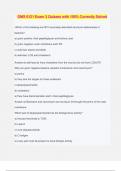
-
GMS 6121 Exam 3 Quizzes with 100% Correctly Solved
- Exam (elaborations) • 18 pages • 2024
-
- $12.49
- + learn more
GMS 6121 Exam 3 Quizzes with 100% Correctly Solved Which of the following are NOT accurately described structural relationships of bacteria? a) gram positive: thick peptidoglycan and teichoic acid b) gram negative: outer membrane and LPS c) acid-fast: waxes and lipids d) wall-less: LOS and cholesterol Answer-d) wall-less do have cholesterol from the host but do not have LOS/LPS Why are gram negative bacteria resistant to bacitracin and vancomycin? a) porins b) they lack the targets for...
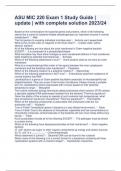
-
ASU MIC 220 Exam 1 Study Guide | update | with complete solution 2023/24
- Exam (elaborations) • 3 pages • 2023
-
- $9.99
- + learn more
ASU MIC 220 Exam 1 Study Guide | update | with complete solution 2023/24 Based on the nomenclature for bacterial genes and proteins, which of the following seems like a name for bacterial malate dehydrogenase (an important enzyme in central metabolism)? - Mdh The first person to visualize individual microbes was: - Antonie van Leewenhoek What is the correct order of reagents in the Gram stain? - Crystal violet, iodine, ethanol, safranin All of the following are true about the outer m...
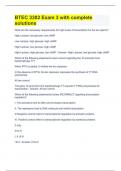
-
BTEC 3302 Exam 3 with complete solutions
- Exam (elaborations) • 16 pages • 2023
-
Available in package deal
-
- $7.99
- + learn more
What are the necessary requirements for high levels of transcription for the lac operon? High Lactose, low glucose, low cAMP Low Lactose, high glucose, high cAMP High Lactose, low glucose, high cAMP High Lactose, high glucose, low cAMP - Answer- High Lactose, low glucose, high cAMP Which of the following statements is/are correct regarding the 10 promoter from bacteriophage T7? When IPTG is added, it inhibits the lac repressor In the absence of IPTG, the lac repressor repres...
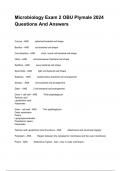
-
Microbiology Exam 2 OBU Plymale 2024 Questions And Answers
- Exam (elaborations) • 4 pages • 2024
-
- $10.39
- + learn more
Coccus - ANS spherical bacterial cell shape Bacillus - ANS rod bacterial cell shape Coccobacillus - ANS short, round rod bacterial cell shape Vibrio - ANS comma/crescent bacterial cell shape Spirillum - ANS wavy bacterial cell shape Spirochete - ANS tight coil bacterial cell shape Staphylo- - ANS cluster/colony bacterial cell arrangement Strepto- - ANS line bacterial cell arrangement Diplo- - ANS ...

-
Chapter 3 - Cell Structure and Function Test with Questions and Answers
- Exam (elaborations) • 9 pages • 2024
-
Available in package deal
-
- $7.99
- + learn more
Chapter 3 - Cell Structure and Function Test with Questions and Answers Phospholipids with an ether link between glycerol and the fatty acids are found in A. plants. B. bacteria. C. fungi. D. archaea. ANSWER archaea. The bacterial cytoskeletal proteins FtsZ and MreB are homologous to the eukaryotic __________ and __________, respectively. A. microtubule; microfilament B. spindle; intermediate filament C. myosin; actin D. tubulin; actin ANSWER tubulin; actin The lipopolysaccharid...
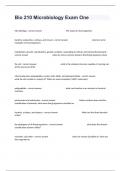
-
Bio 210 Microbiology Exam One Complete Questions And Answers 100% Verified.
- Exam (elaborations) • 21 pages • 2024
-
Available in package deal
-
- $12.99
- + learn more
Microbiology - correct answer The study of microorganisms bacteria, eukaryotes, archaea, and viruses - correct answer what are some examples of microorganisms metabolism, growth, reproduction, genetic variation, responding to stimuli, and internal homeostasis - correct answer what are some common features that living organisms share the cell - corr...

-
Cell Biology Exam 1 Complete Questions And Answers |100% Pass
- Exam (elaborations) • 9 pages • 2023
- Available in package deal
-
- $12.49
- + learn more
Cell Biology Exam 1 Complete Questions And Answers |100% Pass
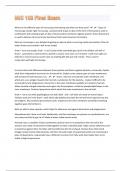
-
MIC 102 Final Exam 97 Questions with 100% Correct Answers | Verified
- Exam (elaborations) • 25 pages • 2023
-
- $7.19
- + learn more
What are the different types of microscopy and staining and when are they used? - ️️Types of microscopy include: light microscopy- used primarily to get an idea of the form of the bacteria, used in combination with staining to get an idea of Gram positive and Gram negative protein. Green fluorescent is used to observe cell occurrences like binary fission and movement of proteins. Electron microscopy is very detailed at getting an idea of what is occurring inside and outside of the cell (whe...
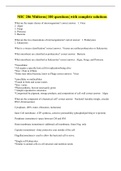
-
MIC 206 Midterm| 100 questions| with complete solutions
- Exam (elaborations) • 13 pages • 2022
-
Available in package deal
-
- $10.49
- + learn more
What are the major classes of microorganisms? correct answer: 1. Virus 2. Algae 3. Fungi 4. Protozoa 5. Bacteria What are the two classications of microorgamisms? correct answer: 1. Prokaryotes 2. Eukaryotes What is a viruses classification? correct answer: Viruses are neither prokaryotes or Eukaryotes. What microbe(s) are classified as prokaryotes? correct answer: Bacteria What microbe(s) are classified as Eukaryotes? correct answer: Algae, Fungi, and Protozoa *Nonc...

-
BIO 235 Microbiology Exam TEST 1(2023-2024)
- Exam (elaborations) • 10 pages • 2023
- Available in package deal
-
- $12.99
- + learn more
BIO 235 Microbiology Exam TEST 1() units of measurement - CORRECT ANSWER1 µm = 10-6 m = 10-3 mm 1 nm = 10-9 m = 10-6 mm 1000 nm = 1 µm 0.001 µm = 1 nm total magnification (compound microscopes) - CORRECT ANSWER-the image from the objective lens is magnified again by the ocular lens -total magnification = objective lens x ocular lens resolution - CORRECT ANSWER-the ability of the lenses to distinguish two points. -shorter wavelengths of light provide greater resolution objective l...

Study stress? For sellers on Stuvia, these are actually golden times. KA-CHING! Earn from your study resources too and start uploading now. Discover all about earning on Stuvia


